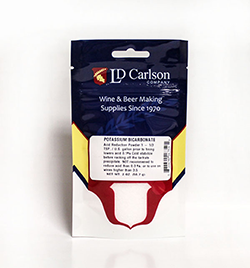Is My Wine's Acidity too High? Potassium Bicarbonate Is an Easy Fix for Sour Wine
Posted by Matteo Lahm on 25th May 2023
Your wine is fermented and you are excited to sample it. As you take your first sip, your face spontaneously contorts, your mouth tightens and your hopes drop. It's sour.
You often read about the dangers and pitfalls of not enough acidity in your wine but what about when you have too much? A pH that is too low comes with its own set of problems and remedies. One of the essential tools in your palette is potassium bicarbonate, a compound that can help you achieve the perfect harmony of acidity in your wine when it is too tart. In this article, we will delve into the intricacies of using potassium bicarbonate in winemaking, exploring its role, when to use it, and other techniques to lower acidity in your wine or must.
The Role of Potassium Bicarbonate in Winemaking:
Potassium bicarbonate (KHCO3) is a white, odorless, and slightly alkaline compound that plays a crucial role in lowering the acidity of your wine. It works by neutralizing excess acid, specifically tartaric acid, in the wine or must. When potassium bicarbonate reacts with tartaric acid, it forms potassium bitartrate, which precipitates out of the solution, effectively reducing the overall acidity of your wine.
When to Use Potassium Bicarbonate:
As a winemaker, you should use potassium bicarbonate when the acidity of your wine or must is too high, resulting in a sharp, sour taste. High acidity can also hinder the fermentation process. Just as yeast struggles when acidity is too low, overly acidic environments are just as problematic. It is essential to measure the acidity of your wine or must using a pH meter or an acid test kit before deciding to use potassium bicarbonate. Generally, a pH range of 3.3 to 3.6 is considered ideal for most wines, while a titratable acidity (TA) of 6 to 7 g/L is suitable for red wines, and 7 to 9 g/L for white wines.
How to Use Potassium Bicarbonate:
To use potassium bicarbonate in your winemaking process, follow these steps:
1. Measure the acidity of your wine or must using a pH meter or an acid test kit.
2. Calculate the required amount of potassium bicarbonate based on the desired reduction in acidity. The general rule of thumb is to use 3.4 grams of potassium bicarbonate per gallon of wine or must to reduce the acidity by 1 g/L.
3. Dissolve the calculated amount of potassium bicarbonate in a small volume of water or wine.
4. Add the dissolved potassium bicarbonate to your wine or must, stirring gently to ensure even distribution.
5. Allow the wine or must to settle for a few days, during which the potassium bitartrate will precipitate out.
6. Rack the wine or must to separate it from the precipitated potassium bitartrate.
Limitations and Alternate Techniques:
Potassium bicarbonate, while an effective tool for reducing acidity in wine, also has its limitations. One of the primary constraints is the maximum amount that can be used without adversely affecting the wine's taste, texture, and stability. Overuse of potassium bicarbonate can lead to an increase in potassium levels, which may cause a salty taste in the wine and negatively impact its overall quality. Additionally, excessive potassium can lead to instability in the wine, causing the formation of unsightly crystals or haziness.
Typically, it is recommended not to exceed a dosage of 3.4 grams of potassium bicarbonate per gallon of wine or must, which corresponds to a reduction of acidity by 1 g/L. This limitation means that if the initial acidity of your wine or must is excessively high, potassium bicarbonate alone may not be sufficient to bring the acidity down to the desired level.
In such cases, it is essential to consider alternative techniques or a combination of methods to lower the acidity to an acceptable range. Some of these techniques include:
1. Blending: By blending your high-acid wine or must with a lower-acid wine or must, you can achieve a more balanced acidity level. This method allows you to maintain the desired flavor profile while avoiding the overuse of potassium bicarbonate.
2. Cold stabilization: This technique involves chilling the wine to encourage the precipitation of tartaric acid, which can then be removed through racking. Cold stabilization can help reduce acidity without the need for additional chemical additives.
3. Malolactic fermentation: This process involves the conversion of malic acid to lactic acid by introducing specific bacteria. Malolactic fermentation results in a softer, less acidic wine, and can be particularly useful for high-acid grape varieties or wines with elevated malic acid levels.
4. Acid reduction by ion exchange or electrodialysis: These advanced techniques involve the use of specialized equipment to remove excess acid from the wine. While these methods can be highly effective in reducing acidity, they may not be feasible for home winemakers due to the cost and complexity of the equipment required.
By employing a combination of methods and carefully monitoring the acidity of your wine or must, you can achieve a well-balanced and enjoyable final product.
Conclusion:
As a home winemaker, mastering the art of balancing acidity is crucial to creating a wine that is both enjoyable and reflective of your unique vision. Potassium bicarbonate is an invaluable tool in your winemaking arsenal, allowing you to reduce excess acidity and achieve the perfect harmony in your wine. By understanding when and how to use potassium bicarbonate, as well as exploring other techniques for managing acidity, you can continue to hone your skills and create wines that are truly a work of art.


